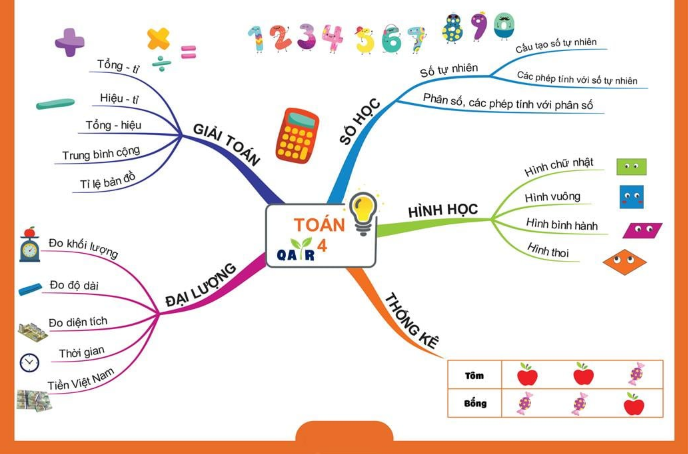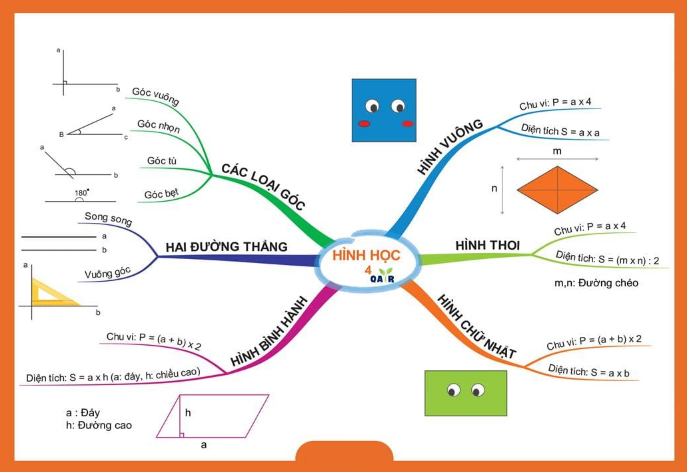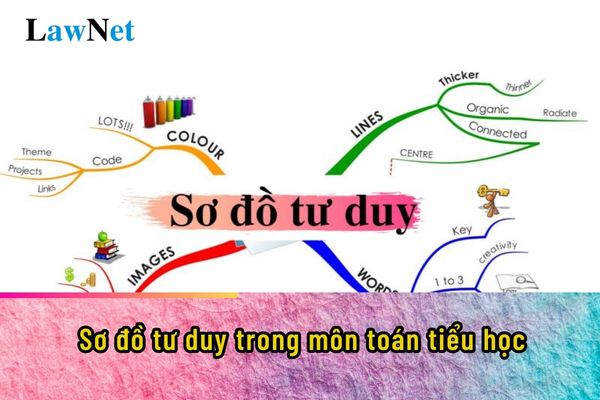What is a mind map in mathematics of primary levels in Vietnam?
What is a mind map in mathematics of primary levels in Vietnam?
A mind map is an incredibly useful tool that helps us remember, organize, and relate information in a visual and effective way. Instead of listing information in a simple list, a mind map uses branches, images, and keywords to create a visual map of ideas, helping the brain easily absorb and retain information.
A mind map in general and in mathematics of primary levels, in particular, includes the main components as follows:
Central keyword: This is the main idea or main topic you want to explore.
Main branches: From the central keyword, you will draw out main branches representing major ideas related to the main topic.
Sub-branches: From the main branches, you continue to draw out smaller sub-branches representing more detailed ideas.
Keywords and images: Each branch will be associated with a concise keyword and may include illustrative images to help you remember better.
Some beautiful examples of mind maps in mathematics of primary levels are provided below for reference.




*Note: Information about mind maps in mathematics of primary levels is for reference purposes only.

What is a mind map in mathematics of primary levels in Vietnam? (Image from the Internet)
What are the characteristics of teaching mathematics of primary levels in Vietnam?
According to Section I, Appendix of the General Education Program for Mathematics issued together with Circular 32/2018/TT-BGDDT, the characteristics of teaching mathematics of primary levels are as follows:
- Mathematics increasingly has many applications in life. Basic mathematical knowledge and skills help individuals solve real-life problems systematically and accurately, contributing to societal development.
- Mathematics in general education helps form and develop essential qualities, general competences, and mathematical competence for students; develops key knowledge and skills and provides opportunities for students to experience and apply mathematics in practice; creates connections between mathematical ideas, between mathematics and real life, between mathematics and other subjects and educational activities, especially with subjects like Science, Natural Science, Physics, Chemistry, Biology, Technology, and Informatics to implement STEM education.
- The content of mathematics is often logical, abstract, and generalized. Therefore, to understand and learn mathematics, the mathematics program in general education needs to ensure a balance between “learning” knowledge and “applying” knowledge to solve specific problems.
- During the process of learning and applying mathematics, students always have opportunities to use modern teaching technology and equipment, especially electronic and handheld calculators, to support discovering and exploring knowledge and solving mathematical problems.
In the general education program, mathematics is a compulsory subject from grade 1 to grade 12. Mathematics education content is divided into two phases:
- Basic education phase: Mathematics helps students understand systematically the most essential mathematical concepts, principles, and rules for everyone, forming a foundation for further education or everyday life use.
- Career orientation education phase: Mathematics provides students with a general view of mathematics, understanding its roles and applications in real life and related fields, which helps in career orientation and the ability to understand mathematics-related issues throughout their lives. Besides the core educational content, each school year, students (particularly those oriented towards natural science and technology) can choose to study specialized topics. These topics aim to enhance knowledge about mathematics, skills in applying mathematical knowledge in practice, meet interests, needs, and career orientations of students.
The mathematics program in both education phases has a linear structure combined with a "concentric spiral" (concentric, expanding, and gradually increasing), revolving around and integrating three knowledge threads: Numbers, Algebra and Elements of Calculus; Geometry and Measurement; Statistics and Probability.
How to ensure differentiation when teaching mathematics of primary levels in Vietnam?
According to Subsection 3, Section II, Appendix of the General Education Program for Mathematics issued together with Circular 32/2018/TT-BGDDT, differentiation when teaching mathematics of primary levels must be ensured as follows:
The mathematics program performs intra-subject integration revolving around three knowledge threads: Numbers, Algebra and Elements of Calculus; Geometry and Measurement; Statistics and Probability; performs interdisciplinary integration through related contents and topics or mathematical knowledge exploited and used in other subjects such as Physics, Chemistry, Biology, Geography, Informatics, Technology, History, Arts, etc.; performs intra-subject and interdisciplinary integration through practical activities and experiences in mathematics education.
Simultaneously, the mathematics program ensures the requirement of differentiation. For all educational levels, mathematics adheres to the spirit of teaching towards the individualization of learners, ensuring that most students (in all regions of the country) meet the program's achievement requirements; also pays attention to specific groups (gifted students, students with disabilities, students with difficult circumstances, etc.). For secondary education, mathematics has a system of in-depth study topics and learning content that helps students enhance knowledge, practice skills, and apply solving real-life problems.
>>> Download the General Education Program for Mathematics issued together with Circular 32/2018/TT-BGDDT

